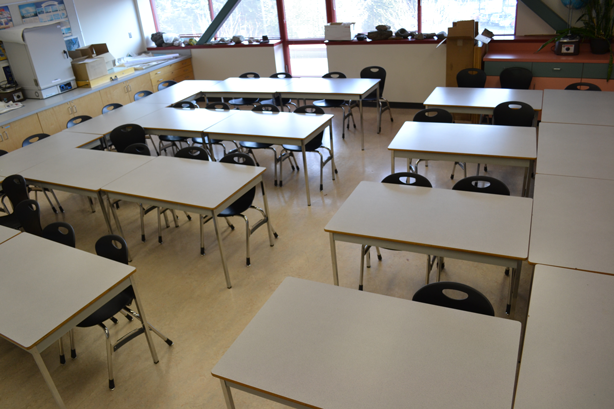Print Edition: February 19, 2014

There is nothing more irritating than hearing the cacophony of chairs and tables grinding across the floor in adjacent or above classrooms during the middle of a lecture. It makes it impossible to concentrate, it disrupts the lecture or discussion, and it happens all the time.
This however, is not the fault of any one class or professor. I have definitely been in classes which have contributed to the chaos. The fact that it happens often seems to indicate a bigger problem. If it is necessary to move the whole room around at the beginning and end of a class, obviously the configuration of tables is not meeting the requirements of an efficient learning environment.
While some classrooms follow a standard organization, many of the ones I sit in are arranged in a way I have never seen outside of UFV. The best way to describe it is two E-shapes opposite each other. This is a disappointing set-up for a few other reasons beyond the awful racket of table-pushing.
One: there is no logical flow to the room. When professors begin to lose their voices and need to break up the lecture routine, the double E set-up makes group discussion and reading in turn awkward. Who is next in the queue?
Two: nearly half the seats don’t face the professor at all; students must turn their heads sideways to see properly and doing this for two or three hours becomes a literal pain in the neck. The chairs in UFV classrooms are uncomfortable enough without having to twist our spines at awkward angles all class. The alternative is to stare off into space while the professor talks — not the best way to absorb important material, and it impacts participation and discussion. How often do you talk to someone’s profile?
Three: as the side tables are usually located fairly close to the walls, students have to shuffle all the way around the wall of the classroom just to use the washroom. Also, students who sit in the middle have to cross through the centre space to leave, which usually means walking directly in front of the professor during a lecture — close enough to give him or her a hug on your way out. Awkward.
Limited access to the door might also make the process of evacuating the classroom during an emergency slower. Nothing about this layout is easy to navigate, and it could create a fumbling, confused escape from the room.
The traditional classroom layout is usually the best option to resolve most if not all of these problems. Tables in rows which face the front of the classroom are the most conducive format for lectures.
It should also be noted UFV offers a number of workshop or discussion-based courses which favour a U-shaped or square layout. This enables everyone in a large group to see each other. Having one or two classrooms set up and regularly used for such classes would be beneficial for students.
Though there may be other classes which require an alternative set up other than the classic tables-in-rows format, I have difficulty imagining the double E model as the best resort.
I am curious to know why the double E arrangement is used in the first place. Classroom set-up falls under janitorial services; is the double E easier to clean? Regardless, the arrangement doesn’t fit well in a learning environment, which is ultimately the classroom’s purpose.

